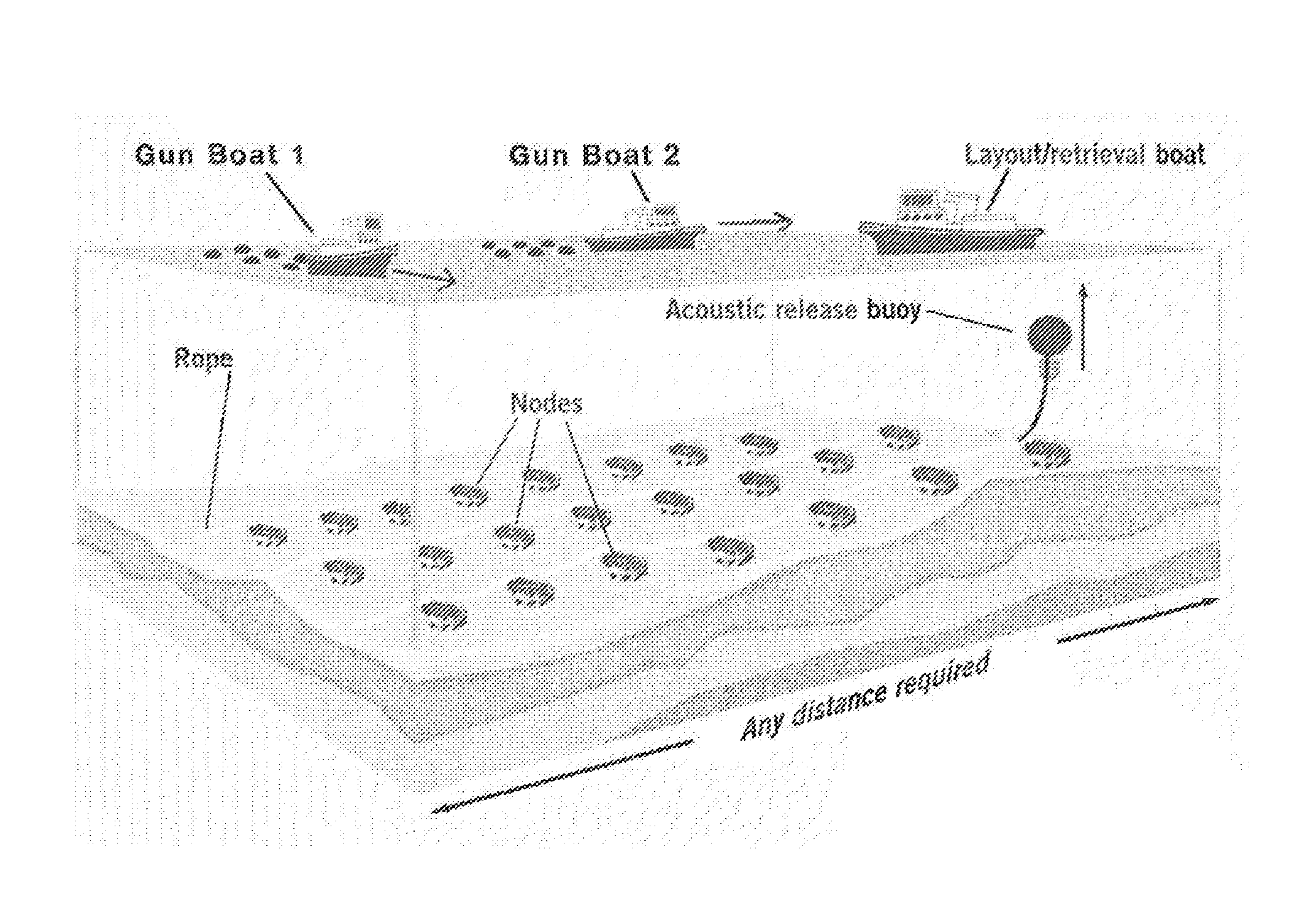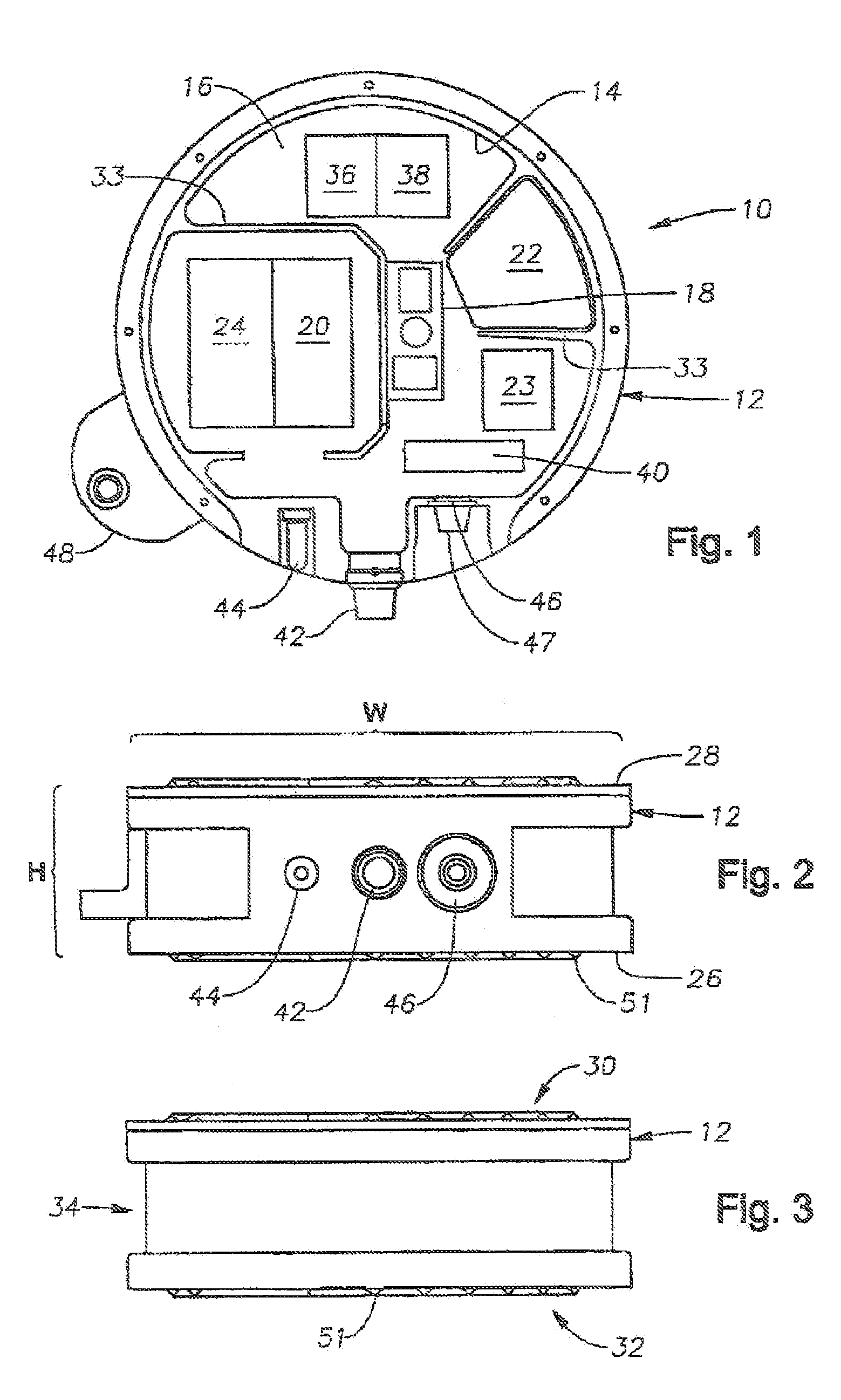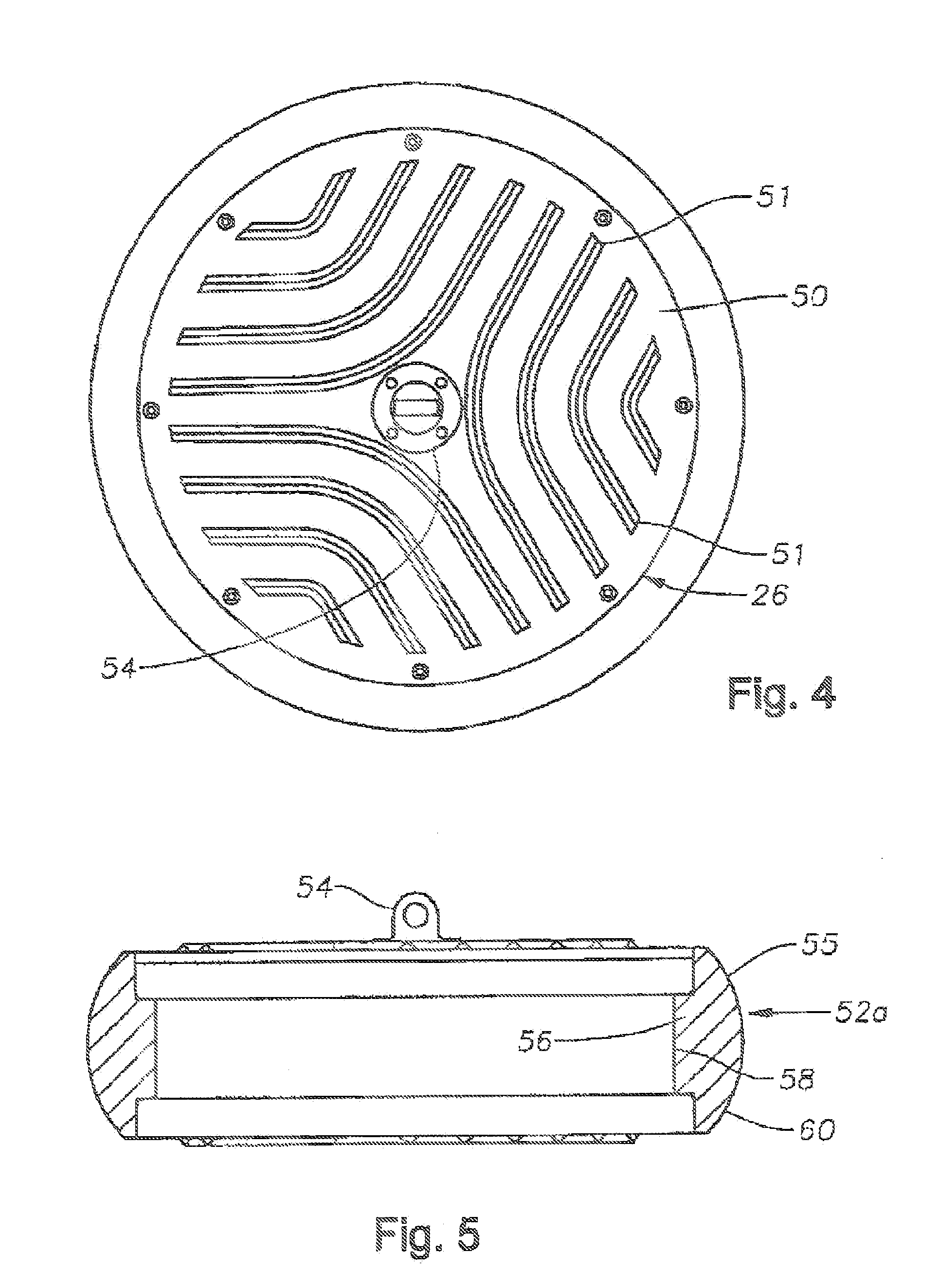While the fundamental process for detection and recording of seismic reflections is the same on land and in marine environments, marine environments present unique problems due to the body of water overlaying the earth's surface, most notably the
high pressure of
deep water activities and the corrosive environment of
salt water activities.
In addition, even simple deployment and retrieval is complicated since operations must be conducted off the
deck of a
seismic exploration vessel, where external elements such as wave action, weather and limited space can greatly affect the operation.
OBC systems such as this can have drawbacks that arise from the physical configuration of the cable.
For example, when three-dimensional geophones are employed, because the cable and geophones are not rigidly coupled to the
sediment on the ocean floor, horizontal motion other than that due to the
sediment, such as for example,
ocean bottom currents, can cause erroneous signals.
Because the recording vessel is in constant physical contact with the cable, the effort required to maintain the vessel's position, wave action and ocean currents can generate-great tension within the cable, increasing the likelihood of a broken cable or failed equipment, as well as the introduction of
signal interference into the cable.
Finally, such cable systems have a high
capital investment and are generally costly to operate.
One drawback to such prior art clocks, however, is that the dock crystals are subject to gravitational and temperature effects.
These gravitational and temperature effects can cause a
frequency shift in the oscillator frequency, thereby resulting in errors in the seismic data.
Since the
clock is typically secured within the OBS
package so as to be correctly oriented when the OBS
system is properly oriented on the ocean floor, any
misorientation of the OBS
system on the ocean floor can result in
clock inaccuracies.
Finally, such clocks often are characterized by drift and time shifts due to temperature changes and aging, which again, can cause inaccuracies in the recorded seismic data.
While it may be possible that mathematical corrections could be made to the data to account for temperature aging and time shifts, there is no prior art device that corrects for gravitational effects on the
crystal clock.
At most, the prior art only corrects for effects of temperature on the
crystal clocks.
To the extent the prior art utilizes gimbals, they are most often incorporated as part of the
geophone itself, which are referred to as “gimbaled geophones.” One drawback to these mechanical gimbals of the prior art is the limited
angular orientation permitted by the devices.
For example, at least one of the prior art devices permit a
gimbal roll of 360° but is limited in
gimbal pitch to 30°.
To the extent the OBS
system is not oriented at least substantially in the horizontal, such as
settling on its side or upside down, the mechanical
gimbal of the prior art may not function properly.
Other gimbaled devices of a mechanical nature are not limited by 30°, however, in such mechanically gimbaled devices, mechanical dampening in the device can deteriorate the fidelity of the recorded
signal.
Finally, gimballing of a
geophone is expensive and requires more space than a non-gimballed
geophone.
For OBS systems that utilize multiple geophones, it may be impractical to gimbal the geophones due to size and
space requirements.
As mentioned above, those skilled in the art will understand that certain environments can present extreme challenges for conventional methods of connecting and controlling the detectors, such as congested or deep marine areas, rugged mountain areas and jungles.
Difficulties may also arise in instances where the
receiver array is periodically moved to cover a larger area.
Whatever the case, each type of connection, whether via a physical cable or through
wireless techniques, has its own drawbacks.
In cable
telemetry systems, large arrays or long streamers result in large quantities of
electrically conductive cabling that are expensive and difficult to
handle, deploy or otherwise manipulate.
In instances where
ocean bottom cabling is used, the corrosive environment and high pressures often require costly cable armoring in water depths over 500 feet.
Since it is generally not practical to hard wire sensors on a cable, the more
conventional technique is to attach cabling to sensors using external connections between the cable and the sensor.
This point of the connection between the cable and the sensor is particularly vulnerable to damage, especially in corrosive,
high pressure marine environments.
The separate units have external connectors that are cabled together, presenting many of the same problems as cabling from the central control on the surface of the water.
In cases where either
wireless technology is utilized or operation of sensors is through pre-
programming, control of the sensors becomes more difficult.
One drawback to this particular design is that the geophones are not coupled directly to the ocean floor.
Rather, any seismic signal recorded by the geophones must pass through the skid and the bottom of the sphere, and in so doing, are subject to
noise and other distortions described above.
As such, seismic data collected by these systems is subject to
noise arising from water movement acting against the devices.
In addition, it has been observed that shear motion caused by movement of the ocean floor under such a tall profile OBS system can cause rocking motion of the OBS system, particularly as the motion translates from the bottom to the top of the unit, further deteriorating-fidelity of the recorded data.
Furthermore, these prior art devices are all asymmetrical, such that they can be positioned in only a single orientation.
However, such a device likely must pass through hundreds of feet of water and contact an often rugged, uneven ocean floor that may be scattered with debris.
All of these factors can result in mis-orientation of the system as it settles on the ocean floor, thereby effecting operation of the system.
For example, to the extent such a prior art OBS system settles on its side, the geophones will not couple with the ocean floor at all, rendering the device unusable.
In addition, incorrect orientation could interfere with the system's release mechanism, jeopardizing
recovery of the system.
The tall profile of these prior art systems is also undesirable because such units lend themselves to becoming entangled in
fishing lines, shrimping nets, various types of cables or other debris that might be present in the vicinity of the seismic recording activity.
On the other hand, prior art systems that have a smaller profile, such as
ocean bottom cables, tend to have poor
coupling ability or require external assistance in placement utilizing expensive equipment such as ROVs.
Furthermore, even along the major axis, because of the small surface area of actual contact between the cable and the ocean floor,
coupling can be compromised due to a rugged ocean bottom or other obstacles on or near the ocean floor.
Another drawback to these prior art systems is the need to activate and deactivate the units for recording and operation.
External control of any type is undesirable since it requires signal transmission and additional components in the system.
While acoustical transmission can be used for some
data transmission, it is generally not reliable to use for synchronization purposes due to unknown travel path variations.
Of course, any type of
control signal cabling for transmission of electrical signals is undesirable because it adds a level of complexity to the handling and control of the unit and requires external connectors or couplings.
A similar problem exists with units that utilize external
electrical wiring to interconnect distributed elements of the unit, such as is taught in U.S. Pat. No. 5,189,642 and similar devices where the geophone
package is separate from the
electronics package.
Furthermore, to the extent the
electronics of a system are distributed, the likelihood of malfunction of the system increases.
Those OBS units that utilize flotation devices for retrieval are undesirable because the typical decoupler device adds additional expense and complexity to the units, and generally must be activated in order to release the systems to the surface.
In addition, such systems typically discard part of the unit, namely the weighted anchor or skid, leaving it as debris on the ocean floor.
During deployment, since they are free-floating, such systems are difficult to position in a desired location on the ocean floor.
Notwithstanding the above-mentioned possibility of malfunction due to
misorientation, during retrieval, the free-floating systems are often difficult to locate and have been known to be lost-at-sea, despite the presence of radio signals and beacons.
Likewise, in tough seas, the units prove unwieldy to snare and lift
on board, often colliding with the boom or vessel
hull and potentially damaging the system.
In this same
vein, handling of the units, both during deployment and retrieval, has proven difficult.
To the extent a rigid or semi-rigid cable system is utilized to fix distances and position individual recorder units, such cables are inflexible, extremely heavy and difficult to manipulate.
Such cables do not lend themselves to corrections during deployment.
However, because of the rigid nature of the cable, the mispositioned portion of the cable will result in all of the remaining units on the cable to be mispositioned along the desired line.
Furthermore, current procedures utilized in the prior art to retrieve cables tends to place undue stress on the cables.
This is undesirable because the speed of the vessel and the speed of the cable
winch must be carefully regulated so as not to overtension or pull the cable.
Such regulation is often difficult because of the various external factors acting on the vessel, such as wind, wave action and water current.
Failure to control tensioning or pulling of the cable will have the effect of dragging the entire length of the line, as well as the units attached thereto, subjecting the entire line and all of the units to damage.
An additional drawback to this method is that if the vessel is moving too fast, it will cause slack in the cable and the cable will float under the vessel, where it can become entangled in the vessel's propellers.
Finally, nowhere in the prior art is there described a back
deck system for handling the above-described OBS units, whether it be storage of the units or deploying and retrieving the units.
Additional surface vessels are costly, as are the personnel necessary to man such vessels.
The presence of additional personnel and vessels also increases the likelihood of accident or injury, especially in open-sea environments where weather can quickly deteriorate.
 Login to View More
Login to View More  Login to View More
Login to View More 


